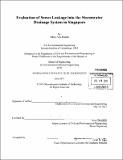Evaluation of sewer leakage into the stormwater drainage system in Singapore
Author(s)
Diagne, Ndeye Awa
DownloadFull printable version (11.13Mb)
Other Contributors
Massachusetts Institute of Technology. Department of Civil and Environmental Engineering.
Advisor
Peter Shanahan.
Terms of use
Metadata
Show full item recordAbstract
Singapore's Public Utilities Board (PUB) aspires to bring Singaporeans closer to their water bodies through recreational activities so that they may cherish them and be more conscious of water scarcity. However, there have been water quality concerns in the reservoirs and the stormwater drains feeding them. In order to protect public health, the point and non-point sources of contamination need to be identified. The purpose of this study was to determine if sewer leaks near building connections are a source of fecal contamination in the stormwater drainage system in Singapore. A two-step study was designed and implemented. First, water samples were collected from the downstream reaches of the stormwater drainage system to the upstream reaches in two high-density residential neighborhoods: Toa Payoh and Choa Chu Kang. The samples were analyzed for total coliform, Escherichia coli (E. coli), and enterococci to identify locations with high bacterial concentrations or hot spots. Then, a tracer study was conducted near a hot spot to determine if pathways exist between the sewer system and the stormwater drains. It was shown that sewers near building connections can leak into the stormwater drains, probably through preferential pathways such as concrete cracks or soil macropores. Sewage does not appear to be traveling through the soil porous medium. Further studies are needed to determine if groundwater is a medium of transport of exfiltrated sewage.
Description
Thesis (M. Eng.)--Massachusetts Institute of Technology, Dept. of Civil and Environmental Engineering, 2013. Cataloged from PDF version of thesis. Includes bibliographical references (p. 61-64).
Date issued
2013Department
Massachusetts Institute of Technology. Department of Civil and Environmental EngineeringPublisher
Massachusetts Institute of Technology
Keywords
Civil and Environmental Engineering.